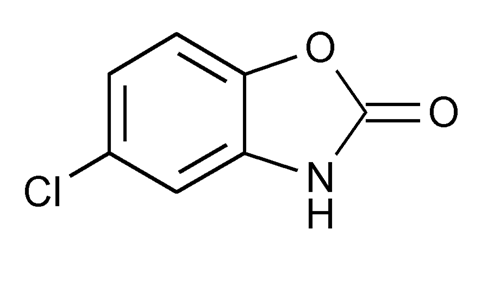Chlorzoxazone
» Chlorzoxazone contains not less than 98.0 percent and not more than 102.0 percent of C7H4ClNO2, calculated on the dried basis.
Packaging and storage—
Preserve in tight containers.
Identification—
A:
Infrared Absorption  197K
197K : previously dried.
: previously dried.
Solution:
20 µg per mL.
Medium:
methanol.
Loss on drying  731
731 —
Dry it at 105
—
Dry it at 105 for 2 hours: it loses not more than 0.5% of its weight.
for 2 hours: it loses not more than 0.5% of its weight.
Heavy metals, Method II  231
231 :
0.002%.
:
0.002%.
Residue on ignition  281
281 :
not more than 0.15%.
:
not more than 0.15%.
Chromatographic purity—
Prepare a Test solution in methanol containing 20 mg per mL. Dissolve a suitable quantity of USP Chlorzoxazone Related Compound A RS (2-Amino-4-chlorophenol) in methanol to obtain a solution containing 100 µg per mL (Standard solution A). Dissolve a suitable quantity of p-chlorophenol in methanol to obtain a solution containing 50 µg per mL (Standard solution B). Apply separate 10 µL portions of the three solutions to the starting line of a suitable thin-layer chromatographic plate (see Chromatography  621
621 ) coated with a 0.25-mm layer of chromatographic silica gel mixture. Allow the spots to dry, and develop the chromatogram in a solvent system consisting of a mixture of hexane and dioxane (63:37) until the solvent front has moved about three-fourths of the length of the plate. Remove the plate from the developing chamber, mark the solvent front, and allow the solvent to evaporate. Locate the spots on the plate by examination under short-wavelength UV light: any spot obtained from the Test solution, other than one corresponding to chlorzoxazone, does not exceed, in size or intensity, the principal spot obtained from Standard solution A, corresponding to not more than 0.5% of any individual impurity. Expose the plate to iodine vapors in a closed chamber, and locate the spots: any spot obtained from the Test solution, other than one corresponding to chlorzoxazone, does not exceed, in size or intensity, the principal spot obtained from Standard solution B, corresponding to not more than 0.25% of any individual impurity.
) coated with a 0.25-mm layer of chromatographic silica gel mixture. Allow the spots to dry, and develop the chromatogram in a solvent system consisting of a mixture of hexane and dioxane (63:37) until the solvent front has moved about three-fourths of the length of the plate. Remove the plate from the developing chamber, mark the solvent front, and allow the solvent to evaporate. Locate the spots on the plate by examination under short-wavelength UV light: any spot obtained from the Test solution, other than one corresponding to chlorzoxazone, does not exceed, in size or intensity, the principal spot obtained from Standard solution A, corresponding to not more than 0.5% of any individual impurity. Expose the plate to iodine vapors in a closed chamber, and locate the spots: any spot obtained from the Test solution, other than one corresponding to chlorzoxazone, does not exceed, in size or intensity, the principal spot obtained from Standard solution B, corresponding to not more than 0.25% of any individual impurity.
Chlorine content—
Dissolve about 300 mg, accurately weighed, in 10 mL of alcohol in a suitable flask. Add 3.5 g of Raney's nickel-aluminum catalyst, and connect to a suitable reflux condenser. Chill the flask in an ice bath, and add through the condenser 75 mL of 2.5 N sodium hydroxide. When the reaction has subsided, remove the ice bath. After 10 minutes, heat the flask gently, gradually increasing the heat until the mixture refluxes rapidly. After 90 minutes from the time of the addition of the alkali, discontinue heating, cool, and rinse the condenser with water, collecting the rinsings in the flask. Transfer the liquid to a 200-mL volumetric flask, wash the residue with water, and add the washing to the volumetric flask. Dilute with water to volume, and mix. Transfer 100.0 mL of this solution to a beaker, neutralize, then acidify (using congo red as the indicator) by adding nitric acid dropwise with mixing. Titrate with 0.1 N silver nitrate VS, determining the endpoint potentiometrically, using silver and calomel electrodes. Each mL of 0.1 N silver nitrate is equivalent to 3.545 mg of Cl: the content of Cl, calculated on the dried basis, is between 20.6% and 21.2%.
Assay—
Transfer about 50 mg of Chlorzoxazone, accurately weighed, to a 100-mL volumetric flask. Dissolve in methanol, dilute with methanol to volume, and mix. Transfer 4.0 mL of this solution to a 100-mL volumetric flask, dilute with methanol to volume, and mix. Concomitantly determine the absorbances of this solution and a Standard solution of USP Chlorzoxazone RS in methanol at a concentration of about 20 µg per mL in 1-cm cells at the wavelength of maximum absorbance at about 282 nm, with a suitable spectrophotometer, using methanol as the blank. Calculate the quantity, in mg, of C7H4ClNO2 in the Chlorzoxazone taken by the formula:
2.5C(AU / AS)
in which C is the concentration, in µg per mL, of USP Chlorzoxazone RS in the Standard solution; and AU and AS are the absorbances of the solution of Chlorzoxazone and the Standard solution, respectively.
Auxiliary Information—
Please check for your question in the FAQs before contacting USP.
Chromatographic Column—
| Topic/Question | Contact | Expert Committee |
| Monograph | Ravi Ravichandran, Ph.D.
Senior Scientist 1-301-816-8330 |
(MDPP05) Monograph Development-Psychiatrics and Psychoactives |
| Reference Standards | Lili Wang, Technical Services Scientist 1-301-816-8129 RSTech@usp.org |
USP32–NF27 Page 1921
Chromatographic columns text is not derived from, and not part of, USP 32 or NF 27.
